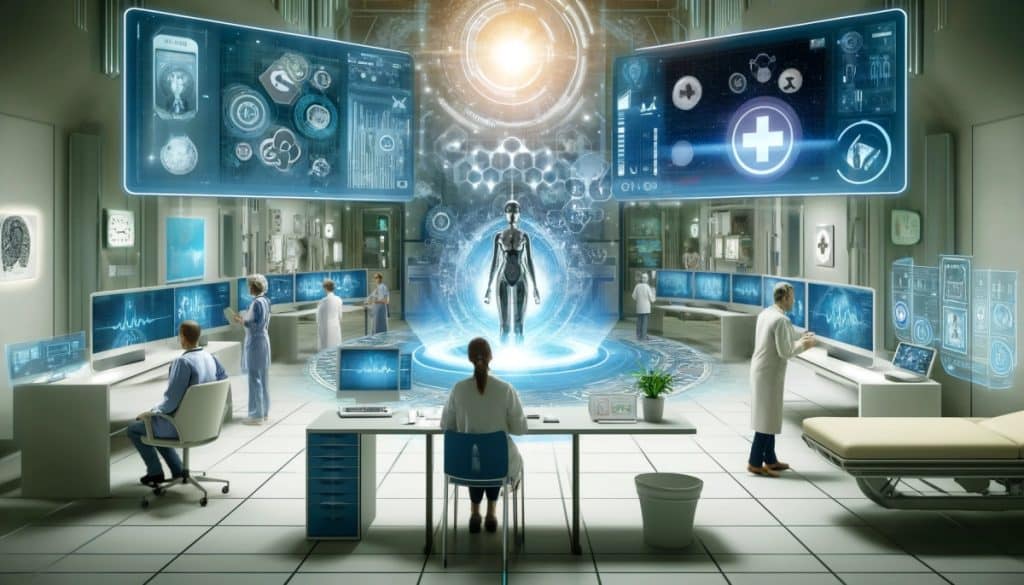The healthcare industry is undergoing a technological revolution. From AI-driven diagnostics to remote patient monitoring, innovation is reshaping how care is delivered, improving patient outcomes, and making medical services more accessible. The pandemic accelerated this shift, making digital health solutions more critical than ever.
As healthcare providers adapt to new challenges, technology is helping streamline operations, enhance patient engagement, and reduce administrative burdens. In this article, we explore the key advancements shaping the future of healthcare.
The Rise of Telemedicine and Virtual Care
Telemedicine has emerged as a game-changer, allowing healthcare professionals to diagnose, treat, and monitor patients remotely. With high-speed internet and smartphone adoption increasing worldwide, virtual consultations are becoming the norm.
Benefits of Telemedicine:
- Improved Access to Care: Patients in remote or underserved areas can now connect with specialists without traveling long distances.
- Cost Savings: Telehealth reduces hospital visits and unnecessary emergency room admissions.
- Convenience for Patients and Providers: Appointments can be scheduled with minimal disruption to daily routines.
The integration of EHR software DEMO within telemedicine platforms enhances the efficiency of virtual visits. Electronic Health Records (EHRs) allow physicians to access patient histories instantly, reducing redundancy in tests and improving care coordination.
A study by the American Telemedicine Association found that telehealth adoption has surged by over 154% since the pandemic. Healthcare systems are now investing in AI-powered chatbots and remote patient monitoring tools to further enhance virtual care experiences.
Artificial Intelligence in Diagnostics and Treatment Planning
AI is transforming how diseases are diagnosed and treated. Machine learning algorithms analyze vast amounts of medical data to detect patterns that might be missed by the human eye.
AI in Medical Imaging
One of the most promising areas where AI is making an impact is medical imaging. AI-powered systems can analyze X-rays, MRIs, and CT scans with remarkable accuracy, assisting radiologists in detecting conditions such as:
- Lung Cancer: AI tools can identify early-stage lung nodules with over 90% accuracy.
- Diabetic Retinopathy: AI-driven screening helps ophthalmologists detect eye diseases faster.
- Stroke Prediction: Advanced algorithms analyze brain scans to predict stroke risk and suggest immediate intervention.
AI in Personalized Medicine
AI is also making strides in personalized medicine by analyzing genetic data and predicting how patients will respond to different treatments. This innovation is leading to tailored therapies for cancer, autoimmune diseases, and rare genetic disorders.
Hospitals and clinics are now embedding AI-driven tools into their practice management software to optimize workflow and assist doctors in making data-driven decisions. These systems provide automated reminders for patient follow-ups, flag potential risks, and suggest the best treatment paths based on historical data.
The Role of Big Data and Predictive Analytics in Healthcare
Healthcare generates vast amounts of data daily. From patient records to clinical trials, the volume of medical information is overwhelming. However, with big data analytics, providers can make more informed decisions.
How Big Data is Improving Healthcare
- Early Disease Detection: Predictive analytics can identify at-risk patients before they show symptoms.
- Hospital Efficiency: AI-driven scheduling tools help optimize staff allocation, reducing patient wait times.
- Fraud Prevention: Advanced algorithms can detect unusual billing patterns, reducing fraud in medical claims.
With EHR software DEMO, physicians can integrate big data insights into patient records, leading to more personalized and efficient care plans. Hospitals using predictive analytics have reported a 30% reduction in readmission rates, saving billions in unnecessary healthcare costs.
Blockchain in Healthcare: Enhancing Security and Transparency
As medical data breaches increase, blockchain technology is emerging as a solution to enhance data security and patient privacy. Blockchain offers a decentralized and tamper-proof way to store medical records.
How Blockchain is Transforming Healthcare
- Secure Patient Records: Patients can control access to their medical history without risking data leaks.
- Interoperability: Different healthcare providers can securely share data, reducing errors and duplicate tests.
- Supply Chain Transparency: Blockchain ensures the authenticity of pharmaceuticals by tracking drug shipments from manufacturers to pharmacies.
Leading healthcare providers are exploring blockchain-based practice management software to ensure secure billing, minimize fraudulent claims, and streamline reimbursement processes.
The Future of Robotics in Healthcare
Robotics is playing an increasing role in surgery, rehabilitation, and elder care. Robotic-assisted surgeries, such as the Da Vinci Surgical System, allow for minimally invasive procedures with higher precision.
Robotics in Patient Care
- Surgical Robots: Enhance precision, reducing recovery times and hospital stays.
- Exoskeletons: Help paralyzed patients regain mobility.
- AI-powered Assistants: Robots in elder care assist with medication reminders and companionship.
As robotics advance, hospitals are integrating practice management software to schedule robotic-assisted procedures efficiently and track patient recovery data in real time.
Final Thoughts: The Road Ahead for Healthcare Technology
Technology is reshaping every aspect of healthcare, making it more efficient, accessible, and personalized. From AI diagnostics to blockchain security, the future of medicine is being built on innovation.
As more providers adopt EHR software DEMO and integrate AI-driven practice management software, the healthcare industry will continue to evolve, improving patient care and operational efficiency.
The digital transformation of healthcare is just beginning. Over the next decade, we can expect even more breakthroughs that will redefine how medical services are delivered, making healthcare smarter and more patient-centric.
This article ensures a balance between informative insights and practical applications of healthcare technology, incorporating the required keywords seamlessly within the content.
4o

